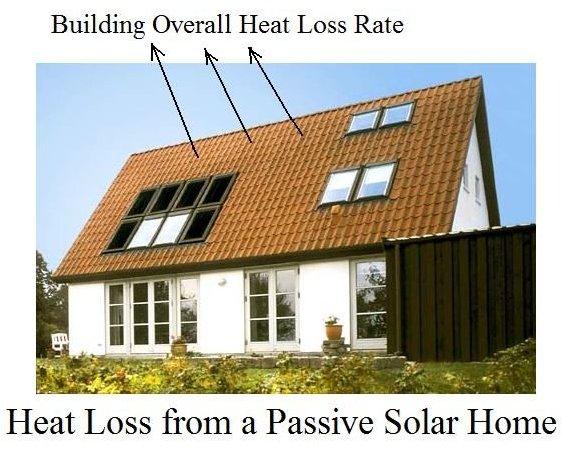Estimation of Building Overall Heat Loss Rate for Passive Solar Heating Design
Typical Values for Overall Building Heat Loss Rate
When the inside of a building is warmer than the outside temperature, it loses heat through windows, through the roof and walls and by air leakage through unsealed spaces. Overall building heat loss rate is often expressed as rate of heat loss per heating degree-day per square foot of building floor area (Btu/oF-day/ft2). See the second article in this series for more about heating degree days and heating degree day data for U.S. locations. An energy conservative, conventional building design should give a heat loss rate of about 6 to 8 Btu/oF-day/ft2. An older home that isn’t well insulated and weather-stripped would have a higher heat loss rate and for a super-insulated home, it would be less.
Goswami, Krieth, & Krieder1, suggest that solarizing the south-facing wall of a building with passive solar heating systems should reduce the rate of heat loss from the building by about 20%. This gives 4.8 - 6.4 Btu/oF-day/ft2, as a target heat loss rate from a well insulated and weatherstripped home with passive solar heating.
Heating Load Calculations (Heat Loss Rate) from Utility Bills
There are several possible approaches for estimating building overall heat loss rate. Anderson & Wells2 describe an approach using fuel consumption information from utility bills for the building. That method is summarized here for use with the following types of heating system: natural gas furnace, fuel oil furnace, electric resistance heating, and heat pump. Estimates of the amount of heat produced per unit of fuel or electricity for the different heating systems can be made as follows:
**
Natural Gas Furnace: One cubic foot of natural gas releases 1000 Btu of energy when it is burned. Multiplying the amount of energy released from the gas by the efficiency of the furnace (anywhere from 50 to 90+%) gives the amount of heat delivered to the building. Natural gas usage is often given as hundreds of cubic feet (ccf) or thousands of cubic feet (mcf) on a utility bill.
Fuel Oil Furnace: The energy content of a gallon of fuel oil is 135,000 to 140,000 Btus. As with a natural gas furnace the energy released from the fuel oil must be multiplied by the furnace efficiency (40 to 70%) to get the heat delivered to the building.
Electric Resistance Heating: Electric resistance heating converts the electricity completely to heat at a rate of 3400 Btu per kilowatt hour (kwh).
Heat Pump: A heat pump will deliver up to 6800 Btus per kwh of electricity used to operate it.
These conversions can be used together with information from power bills on the amount of the fuel or electricity used, to estimate the amount of heat delivered to the building for any month or for the entire heating season. By the first law of thermodynamics (conservation of energy) the average rate that heat was delivered to the building must be equal to the average overall building heat loss rate for any period of time.
Example Calculations
Problem Statement: The table below gives data on monthly natural gas use for a 2000 ft2 home in Albuquerque, NM. Monthly heating degree days for Albuquerque are also included, from the table in ‘Data on Heating Degree Days for Passive Solar Heating Systems in the U.S.’ Assuming 60% efficiency for the furnace, estimate the overall building heat loss rate from this home in Btu/oF-day/ft2.
Month…………………..Jan….Feb….Mar….Apr….May….Jun….Jul….Aug….Sep….Oct….Nov….Dec….year
Nat’l Gas use, ccf……272….186…..95…..73……27…….15…..18…..17……17……28…..91……186….1025
Heating oF-days………955….700….561…301…..89……..0……..0…….0……18….259….621…..921….4425
Solution: 1) Estimate the monthly non-heating gas use: Ave. gas used for June - Aug. (zero heating degree day months) is: (15 + 18 + 17)/3 = 17 ccf/month
- Estimate the total yearly gas use for heating as the total used for the 9 month heating season (Sept - May) minus the 17 ccf/mo used for non-heating purposes:
Annual gas use = (272 + 186 + 95 + 73 + 27 + 17 + 28 + 91 + 186) - (9)(17) = 822 ccf
- Convert to Btu: Gas energy used for heating = (822 ccf)(105 Btu/ccf) = 8.22 x 107 Btu
-
Calc. heat delivered to home (60% efficiency) = (0.6)(8.22 x 107) = 4.93 x 107 Btu
-
Divide by annual heating degree days and the floor area of the house:
Overall building heat loss rate = (4.93 x 107)/4425/2000 = 5.6 Btu/oF-day/ft2
Note that this is within the range of 4.6 to 6.4 Btu/oF-day/ft2 for a well insulated house with some solar input from south-facing windows.
References
1. Goswami, D.Y., Krieth, F. & Kreider, J.F., Principles of Solar Engineering, Philadelphia, Taylor & Francis, 2000
2. Anderson, B. & Wells, M., Passive Solar Energy: The Homeowners Guide to Natural Heating and Cooling, Andover MA, Brickhouse Publishing Co. 1981. (available for free download at: www.builditsolar.com/Projects/SolarHomes/PasSolEnergyBk/PSEbook.htm.
About the Author
Dr. Harlan Bengtson is a registered professional engineer with 30 years of university teaching experience in engineering science and civil engineering. He holds a PhD in Chemical Engineering.
This post is part of the series: Passive Solar Design Calculations
Passive solar heating systems use components of a building, building orientation, and building design to provide passive solar heat. Calculations involving heating degree days, building heat loss rate and solar insolation data can predict the performance of a passive solar heating system.
- Principles of Passive Solar Heating Systems and How They Work
- Heating Degree Days for Passive Solar Heating Systems in the U.S.
- Estimation of Heat Loss/Heating Needs from Your Utility Bills
- Solar Insolation Data for Passive Solar Heating at Your Location in the U.S.
- Estimating Passive Solar Heating System Performance
